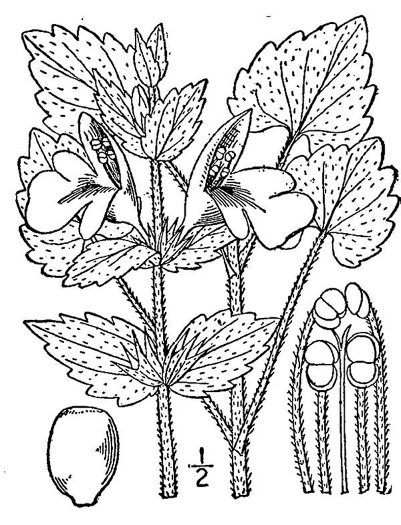Spermatophytes (seed plants): Angiosperms (flowering plants): Eudicots: Core Eudicots: Asterids: Lamiids: Lamiales
WEAKLEY'S FLORA OF THE SOUTHEASTERN US (4/24/22):
Synandra hispidula
FAMILY
Lamiaceae
Go to FSUS key
Dig deeper at SERNEC, a consortium of southeastern herbaria.
This is one of the more spectacular spring wildflowers in Great Smoky Mountains National Park and farther west. Sadly, hardly anyone has ever seen it in NC. read more at Vascular Plants of North Carolina.
SYNONYMOUS WITH
PLANTS NATIONAL DATABASE:
Synandra hispidula
FAMILY
Lamiaceae
SYNONYMOUS WITH Floristic Synthesis of North America. BONAP (Kartesz, 2021)
Synandra hispidula
SYNONYMOUS WITH VASCULAR FLORA OF THE CAROLINAS (Radford, Ahles, & Bell, 1968) 164-15-001:
Synandra hispidula FAMILY Lamiaceae
SYNONYMOUS WITH Manual of the Southeastern Flora (Small, 1933, 1938)
Synandra hispidula
COMMON NAME:
Guyandotte Beauty, Synandra
To see larger pictures, click or hover over the thumbnails.
WEAKLEY'S FLORA OF THE SOUTHEASTERN US (4/24/22):
Synandra hispidula
FAMILY
Lamiaceae
SYNONYMOUS WITH
PLANTS NATIONAL DATABASE:
Synandra hispidula
FAMILY
Lamiaceae
SYNONYMOUS WITH
Floristic Synthesis of North America. BONAP (Kartesz, 2021)
Synandra hispidula
SYNONYMOUS WITH
VASCULAR FLORA OF THE CAROLINAS (Radford, Ahles, & Bell, 1968) 164-15-001:
Synandra hispidula
FAMILY
Lamiaceae
SYNONYMOUS WITH
Manual of the Southeastern Flora (Small, 1933, 1938)
Synandra hispidula
If a search such as "Carex leptalea var. leptalea" doesn't deliver the results you want, try "Carex leptalea".
Or, to minimize chances of a misspelling, try just "Carex le".
Less is more: If "pencil flower" doesn't deliver the results you want, try "pencil".


